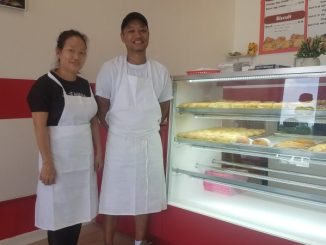
The high temperatures that will be with us from now until October take their toll on some vegetables – although others like it hot. To be successful, you should plan your garden accordingly.
For example, tomatoes set less fruit and snap beans produce poor quality beans when it’s hot. But others, like okra, southern peas and many more, can produce well through the summer.
In fact, for some vegetables, the hotter it is, the better they like it. As you remove the last of the cool-season crops or plantings of early summer vegetables such as snap beans, these hot-weather vegetables are ideal to plant in your garden.
One of them – okra – is an item you could hardly have a Southern garden without. Plant seeds now into well-prepared beds, spacing the seeds 4 inches to 6 inches apart. Water frequently, and when the seeds come up, thin the seedlings to about 12 inches. Production usually begins in 50 to 60 days and continues until fall. Harvest the pods frequently while they are small and tender.
Southern peas are easy, productive and delicious. Excellent varieties include Mississippi Silver, Purple Hull, Whippoorwill, Blackeye and Elite. They grow on short vines and do not require trellises.
Members of the cucumber family that can be planted now include cantaloupe, cassabanana, cucuzzi, luffa, mirliton (plant sprouted fruit), pumpkin and watermelon Although squash and cucumbers can be planted now, production is difficult during mid-summer because of pest problems.
Other vegetables that can be planted now are amaranth, collards, eggplant (the long, skinny oriental types are more productive in heat), Jerusalem artichokes, Malabar spinach, New Zealand spinach, peanuts, hot peppers, sweet peppers (Banana, Gypsy), sweet potato (slips), Swiss chard, tomatillo and tomato (heat-tolerant types such as Heatwave, Solar Set and Sunleaper).
Yardlong beans are easy to grow and are not demanding. If beds are fertile, little or no additional fertilizer is needed during bed preparation. In fact, too much nitrogen causes rampant vine growth and fewer beans.
For planting yardlong beans, choose a site in full sun. Loosen the soil to a depth of 8-10 inches and mix in compost or composted manure.
Yardlong bean vines must be provided something to climb on. Tripods or row trellising with poles and string or netting are effective. Whatever method you choose, make it at about 7 feet high to accommodate the vines. If using a tripod system, plant three seeds to each pole. If using a row trellis, plant the seeds 6 inches a part. The seeds are planted about 1 inch deep and should be up in a week or so.
As with snap beans, the part of this plant commonly eaten is the immature seed pod. Harvest when the beans are smaller than the diameter of a pencil – before the seeds have filled out inside and when the pods still snap when bent. That generally means when they are about 12 inches to 18 inches long.
You may need to harvest daily, since continuous picking keeps the plants producing. The plants will stop producing if beans are left to mature.
Although the beans will keep several days in the refrigerator, they are best eaten soon after harvesting. Like snap beans, they are snapped into 1-inch to 2-inch pieces just before cooking. They can also be snapped, blanched and frozen for longer storage.
Some people think the flavor of the cooked yardlong bean is similar to asparagus (this vegetable is also called asparagus bean). They do have a more dense texture than snap beans and a more intense “bean” flavor, and they are a delicious substitute for snap beans when temperatures are too high for snap beans to thrive. Their texture and flavor hold up well when stir-fried or steamed.
If the beans are left to mature on the vine, their pods will reach lengths up to 3 feet, and the seeds can be shelled out and cooked as other southern peas.
Yardlong beans also make a great addition to a kid’s garden during the summer. Children love the long beans, which may grow to be almost as long as a child is tall. Grow yardlong beans on a tripod of poles, and the young gardener can crawl inside the “teepee,” using it as a shady retreat from the heat.




Be the first to comment